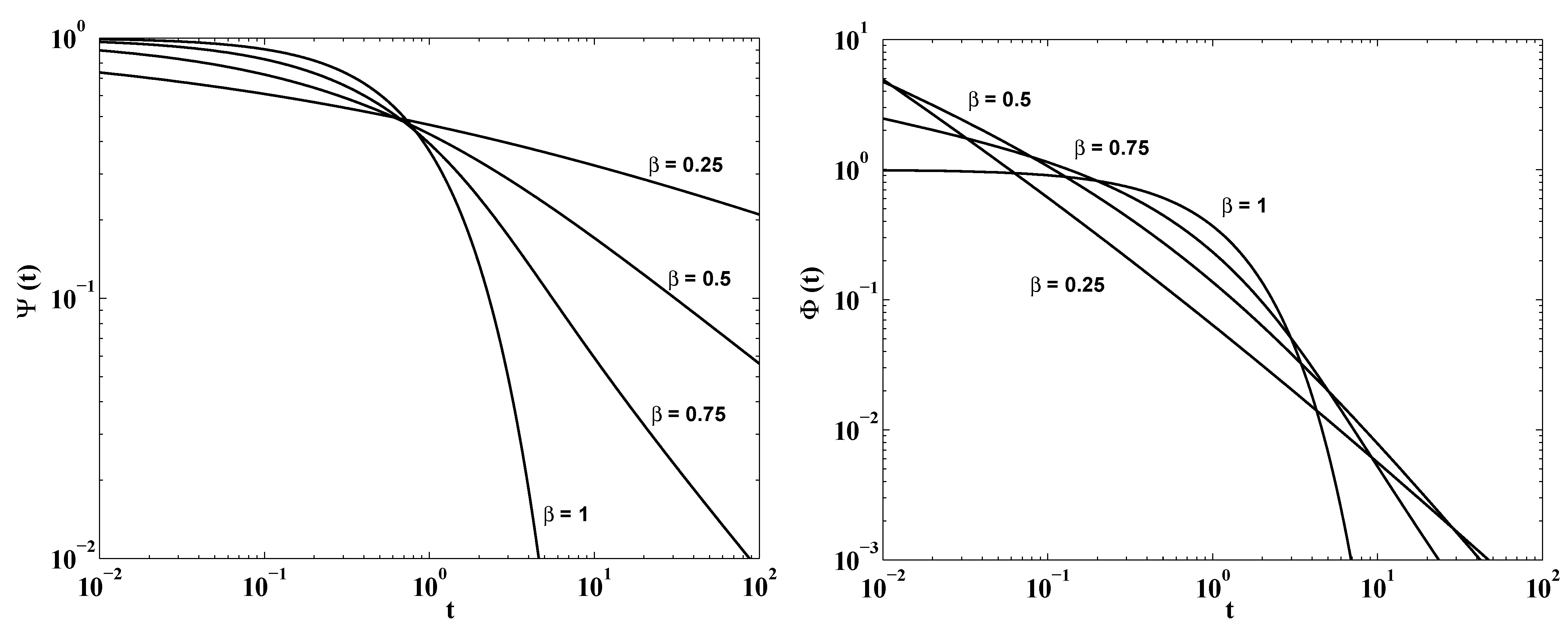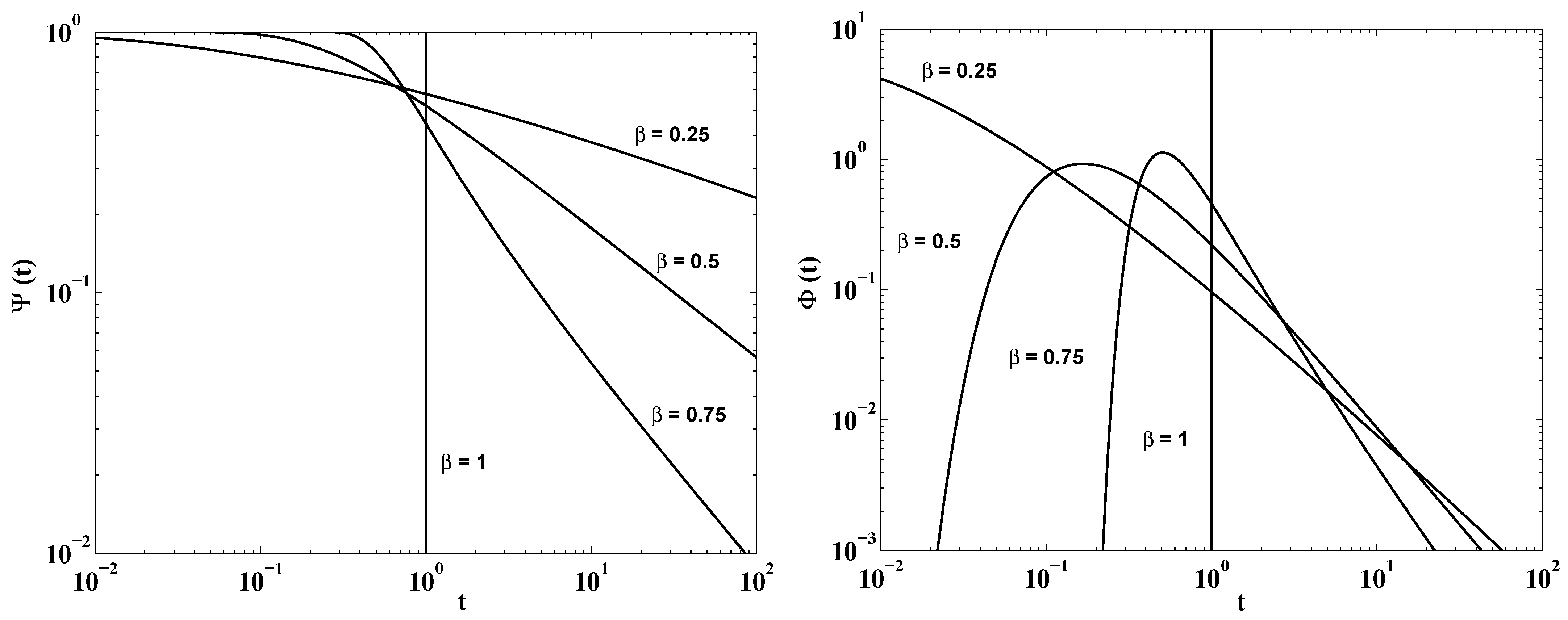On the Fractional Poisson Process and the Discretized Stable Subordinator
Abstract
:1. Introduction
2. Elements of Renewal Theory and CTRW
2.1. The General Renewal Process
2.2. The Counting Number Process and Its Inverse
2.3. The Continuous time Random Walk
2.4. Renewal Process as a Special CTRW
3. The Poisson Process and Its Fractional Generalization

4. The Stable Subordinator and the Wright Process

5. The Diffusion Limits for the Fractional Poisson and the Wright Processes
The Diffusion Limit for the Erlang Process
6. Conclusions
Acknowledegments
Author Contributions
Conflicts of Interest
Appendix A: Operators, Transforms and Special Functions
A.1. Fourier and Laplace Transforms
A.2. Convolutions
A.3. Fractional Integral
A.4. Fractional Derivatives
A.5. Mittag-Leffler and Wright Functions
Appendix B: Collection of Results
B.1. General Renewal Process
B.2. Special Cases
References
- Repin, O.N.; Saichev, A.I. Fractional Poisson law. Radiophys. Quantum Electron. 2000, 43, 738–741. [Google Scholar] [CrossRef]
- Wang, X.; Wen, Z. Poisson fractional processes. Chaos Solitons Fractals 2003, 18, 169–177. [Google Scholar] [CrossRef]
- Wang, X.; Wen, Z.; Zhang, S. Fractional Poisson process (II). Chaos Solitons Fractals 2006, 28, 143–147. [Google Scholar] [CrossRef]
- Laskin, N. Fractional Poisson process. Commun. Nonlinear Sci. Numer. Simul. 2003, 8, 201–213. [Google Scholar] [CrossRef]
- Laskin, N. Some applications of the fractional Poisson probability distribution. J. Math. Phys. 2009, 50, 113513:1–113513:12. [Google Scholar] [CrossRef]
- Mainardi, F.; Gorenflo, R.; Scalas, E. A fractional generalization of the Poisson processes. Vietnam J. Math. 2004, 32, 53–64. Available online: http://arxiv.org/abs/math/0701454 (accessed on 3 August 2015). [Google Scholar]
- Uchaikin, V.V.; Cahoy, D.O.; Sibatov, R.T. Fractional processes: From Poisson to branching one. Int. J. Bifurcation Chaos 2008, 18, 1–9. [Google Scholar] [CrossRef]
- Beghin, L.; Orsingher, E. Fractional Poisson processes and related random motions. Electron. Journ. Prob. 2009, 14, 1790–1826. [Google Scholar] [CrossRef]
- Cahoy, D.O.; Uchaikin, V.V.; Woyczynski, W.A. Parameter estimation for fractional Poisson processes. J. Stat. Plan. Inference 2010, 140, 3106–3120. [Google Scholar] [CrossRef]
- Meerschaert, M.M.; Nane, E.; Vellaisamy, P. The fractional Poisson process and the inverse stable subordinator. Electron. J. Prob. 2011, 16, 1600–1620. Available online: http://arxiv.org/abs/1007.505 (accessed on 3 August 2015). [Google Scholar] [CrossRef]
- Politi, M.; Kaizoji, T.; Scalas, E. Full characterization of the fractional Poisson process. Eur. Phys. Lett. 2011, 96, 20004:1–20004:6. [Google Scholar] [CrossRef]
- Kochubei, A.N. General fractional calculus, evolution equations, and renewal processes. Integral Equ. Oper. Theory 2011, 71, 583–600. Available online: http://arxiv.org/abs/1105.1239 (accessed on 3 August 2015). [Google Scholar] [CrossRef]
- Hilfer, H.; Anton, L. Fractional master equations and fractal time random walks. Phys. Rev. E 1995, 51, R848–R851. [Google Scholar] [CrossRef]
- Mainardi, F.; Raberto, M.; Gorenflo, R.; Scalas, E. Fractional calculus and continuous-time finance II: The waiting-time distribution. Phys. A 2000, 287, 468–481. Available online: http://arxiv.org/abs/cond-mat/0006454 (accessed on 3 August 2015). [Google Scholar] [CrossRef]
- Mainardi, F.; Gorenflo, R.; Vivoli, A. Renewal processes of Mittag-Leffler and Wright type. Fract. Calc. Appl. Anal. 2005, 8, 7–38. Available online: http://arxiv.org/abs/math/0701455 (accessed on 3 August 2015). [Google Scholar]
- Mainardi, F.; Gorenflo, R.; Vivoli, A. Beyond the Poisson renewal process: A tutorial survey. J. Comp. Appl. Math 2007, 205, 725–735. [Google Scholar] [CrossRef]
- Barkai, E. CTRW pathways to the fractional diffusion equation. Chem. Phys. 2002, 284, 13–27. [Google Scholar] [CrossRef]
- Gorenflo, R.; Mainardi, F.; Vivoli, A. Continuous time random walk and parametric subordination in fractional diffusion. Chaos Solitons Fractals 2007, 34, 87–103. Available online: http://arxiv.org/abs/cond-mat/0701126 (accessed on 3 August 2015). [Google Scholar] [CrossRef]
- Fogedby, H.C. Langevin equations for continuous time Lévy flights. Phys. Rev. E 1994, 50, 1657–1660. [Google Scholar] [CrossRef]
- Kleinhans, D.; Friedrich, R. Continuous-time random walks: Simulations of continuous trajectories. Phys. Rev E 2007, 76, 061102:1–061102:6. [Google Scholar] [CrossRef] [PubMed]
- Gorenflo, R.; Mainardi, F. Subordination pathways to fractional diffusion. Eur. Phys. J. Spec. Top. 2011, 193, 119–132. Available online: http://arxiv.org/abs/1104.4041 (accessed on 3 August 2015). [Google Scholar] [CrossRef]
- Gorenflo, R.; Mainardi, F. Parametric Subordination in Fractional Diffusion Processes. In Fractional Dynamics; Klafter, J., Lim, S.C., Metzler, R., Eds.; World Scientific: Singapore, 2012; Chapter 10; pp. 229–263. Available online: http://arxiv.org/abs/1210.8414 (accessed on 3 August 2015).
- Gnedenko, B.V.; Kovalenko, I.N. Introduction to Queueing Theory; Israel Program for Scientific Translations: Jerusalem, Israel, 1968. [Google Scholar]
- Balakrishnan, V. Anomalous diffusion in one dimension. Phys. A 1985, 132, 569–580. [Google Scholar] [CrossRef]
- Gorenflo, R.; Mainardi, F. Continuous time random walk, Mittag-Leffler waiting time and fractional diffusion: Mathematical aspects. In Anomalous Transport: Foundations and Applications; Klages, R., Radons, G., Sokolov, I.M., Eds.; Wiley-VCH: Weinheim, Germany, 2008; Chapter 4; pp. 93–127. Available online: http://arxiv.org/abs/0705.0797 (accessed on 3 August 2015).
- Gorenflo, R. Mittag-Leffler waiting time, power laws, rarefaction, continuous time random walk, diffusion limit. In Proceedings of the National Workshop on Fractional Calculus and Statistical Distributions, CMS Pala Campus, India, 25–27 November 2010; Pai, S.S., Sebastian, N., Nair, S.S., Joseph, D.P., Kumar, D., Eds.; pp. 1–22. Available online: http://arxiv.org/abs/1004.4413 (accessed on 3 August 2015).
- Gorenflo, R.; Mainardi, F. Laplace-Laplace analysis of the fractional Poisson process. In Analytical Methods of Analysis and Differential Equations; Rogosin, S., Ed.; Belarusan State University: Minsk, Belarus, 2012; Kilbas Memorial Volume, pp. 43–58. Available online: http://arxiv.org/abs/1305.5473 (accessed on 3 August 2015).
- Bazhlekova, E. Subordination principle for a class of fractional order differential equations. Mathematics 2015, 2, 412–427. [Google Scholar] [CrossRef]
- Meerschaert, M.M. Fractional Calculus, Anomalous Diffusion, and Probability. In Fractional Dynamics; Lim, S.C., Klafter, J., Metzler, R., Eds.; World Scientific: Singapore, 2012; Chapter 11; pp. 265–284. [Google Scholar]
- Meerschaert, M.M.; Benson, D.A.; Scheffler, H.-P.; Baeumer, B. Stochastic solution of space-time fractional diffusion equations. Phys. Rev. E 2002, 65, 41103:1–41103:4. [Google Scholar] [CrossRef] [PubMed]
- Umarov, S. Continuous time random walk models for fractional space-time diffusion equations. Fract. Calc. Appl. Anal. 2015, 18, 821–837. [Google Scholar] [CrossRef]
- Gel’fand, I.M.; Shilov, G.E. Generalized Functions; Academic Press: New York, NY, USA, 1964; Volume 1. [Google Scholar]
- Ross, S.M. Stochastic Processes, 2nd ed.; Wiley: New York, NY, USA, 1996. [Google Scholar]
- Brockmeyer, E.; Halstrøm, H.L.; Jensen, A. The Life and Works of A.K. Erlang, Transactions of the Danish Academy of Technical Sciences, No 2; The Copenhagen Telephone Company: Copenhagen, Denmark, 1948. [Google Scholar]
- Montroll, E.W.; Weiss, G.H. Random walks on lattices, II. J. Math. Phys. 1965, 6, 167–181. [Google Scholar] [CrossRef]
- Weiss, G.H. Aspects and Applications of Random Walks; North-Holland: Amsterdam, The Netherlands, 1994. [Google Scholar]
- Cox, D.R. Renewal Theory, 2nd ed.; Methuen: London, UK, 1967. [Google Scholar]
- Metzler, R.; Klafter, J. The random walker’s guide to anomalous diffusion: A fractional dynamics approach. Phys. Rep. 2000, 339, 1–77. [Google Scholar] [CrossRef]
- Metzler, R.; Klafter, J. The restaurant at the end of the random walk: Recent developments in the description of anomalous transport by fractional dynamics. J. Phys. A. Math. Gen. 2004, 37, R161–R208. [Google Scholar] [CrossRef]
- Chechkin, A.V.; Hofmann, M.; Sokolov, I.M. Continuous-time random walk with correlated waiting times. Phys. Rev. E 2009, 80. [Google Scholar] [CrossRef] [PubMed]
- Baleanu, D.; Diethelm, K.; Scalas, E.; Trujillo, J.J. Fractional Calculus: Models and Numerical Methods; World Scientific: Singapore, 2012. [Google Scholar]
- Scalas, E. A class of CTRWs: Compound fractional Poisson processes. In Fractional Dynamics; Klafter, J., Lim, S.C., Metzler, R., Eds.; World Scientific: Singapore, 2012; Chapter 15; pp. 353–374. [Google Scholar]
- Uchaikin, V.V. Fractional Derivatives for Physicists and Engineers, Vol. I, Background and Theory; Springer: Heidelberg, Germany, 2013. [Google Scholar]
- Podlubny, I. Fractional Differential Equations; Academic Press: San Diego, CA, USA, 1999. [Google Scholar]
- Khintchine, A.Y. Mathematical Methods in the Theory of Queuing; Charles Griffin: London, UK, 1960. [Google Scholar]
- Rogosin, S.V.; Mainardi, F. The Legacy of A.Ya. Khintchine’s Work in Probability Theory; Cambridge Scientific Publ.: Cambridge, UK, 2011; Available online: http://www.cambridgescientificpublishers.com/ (accessed on 3 August 2015).
- Feller, W. An Introduction to Probability Theory and its Applications; Wiley: New York, NY, USA, 1971; Volume II. [Google Scholar]
- Sato, K.-I. Lévy Processes and Infinitely Divisible Distributions; Cambridge University Press: Cambridge, UK, 1999. [Google Scholar]
- Mainardi, F.; Luchko, Y.; Pagnini, G. The fundamental solution of the space-time fractional diffusion equation. Fract. Calc. Appl. Anal. 2001, 4, 153–192. [Google Scholar]
- Mainardi, F. Fractional Calculus and Waves in Linear Viscoelasticity; Imperial College Press: London, UK, 2010. [Google Scholar]
- Gorenflo, R.; Abdel-Rehim, E. From power laws to fractional diffusion: The direct way. Vietnam J. Math. 2004, 32, 65–75. [Google Scholar]
- Gorenflo, R.; Mainardi, F. Fractional calculus: Integral and differential equations of fractional order. In Fractals and Fractional Calculus in Continuum Mechanics; Carpinteri, A., Mainardi, F., Eds.; Springer Verlag: Wien, Austria, 1997; pp. 223–276. Available online: http://arxiv.org/abs/0805.3823 (accessed on 3 August 2015).
- Gorenflo, R.; Mainardi, F.; Scalas, E.; Raberto, M. Fractional calculus and continuous-time finance III: The diffusion limit. In Mathematical Finance; Kohlmann, M., Tang, S., Eds.; Birkhäuser Verlag: Basel, Swizerland, 2001; pp. 171–180. [Google Scholar]
- Mainardi, F.; Mura, A.; Pagnini, G. The M-Wright function in time-fractional diffusion processes: A tutorial survey. Int. J. Diff. Equ. 2010, 2010, 104505:1–104505:29. Available online: http://arxiv.org/abs/1004.2950 (accessed on 3 August 2015). [Google Scholar] [CrossRef]
- Scalas, E.; Gorenflo, R.; Mainardi, F. Fractional calculus and continuous-time finance. Phys. A 2000, 284, 376–384. Available online: http://arxiv.org/abs/cond-mat/0001120 (accessed on 3 August 2015). [Google Scholar] [CrossRef]
- Scalas, E.; Gorenflo, R.; Mainardi, F. Uncoupled continuous-time random walks: Solution and limiting behavior of the master equation. Phys. Rev. E 2004, 69, 011107:1–011107:8. [Google Scholar] [CrossRef] [PubMed]
- Gorenflo, R.; Kilbas, A.A.; Mainardi, F.; Rogosin, S.V. Mittag-Leffler Functions, Related Topics and Applications; Springer: Heidelberg, Germany, 2014. [Google Scholar]
- Kilbas, A.A.; Saigo, M. H-Transform: Theory and Applications; Chapman and Hall/CRC: New York, NY, USA, 2004. [Google Scholar]
- Kilbas, A.A.; Srivastava, H.M.; Trujillo, J.J. Theory and Applications of Fractional Differential Equations; Elsevier: Amsterdam, The Netherlands, 2006. [Google Scholar]
- Mathai, A.M.; Haubold, H.J. Special Functions for Applied Scientists; Springer: New York, NY, USA, 2008. [Google Scholar]
- Mathai, A.M.; Saxena, R.K.; Haubold, H.J. The H-function, Theory and Applications; Springer Verlag: New York, NY, USA, 2010. [Google Scholar]
- Diethelm, K. The Analysis of Fractional Differential Equations. An Application Oriented Exposition Using Differential Operators of Caputo Type; Springer: Berlin, Germany, 2010. [Google Scholar]
- Atanacković, T.M.; Pilipović, S.; Stanković, B.; Zorica, D. Fractional Calculus with Applications in Mechanics: Vibrations and Diffusion Processes; ISTE Ltd, London and John Wiley: Hoboken, NJ, USA, 2014. [Google Scholar]
- Haubold, H.J.; Mathai, A.M.; Saxena, R.K. Mittag-Leffler functions and their applications. J. Appl. Math. 2011, 2011, 298628:1–298628:51. [Google Scholar] [CrossRef]
- Abramowitz, M.; Stegun, I.A. Handbook of Mathematical Functions; Dover: New York, NY, USA, 1965. [Google Scholar]
© 2015 by the authors; licensee MDPI, Basel, Switzerland. This article is an open access article distributed under the terms and conditions of the Creative Commons Attribution license (http://creativecommons.org/licenses/by/4.0/).
Share and Cite
Gorenflo, R.; Mainardi, F. On the Fractional Poisson Process and the Discretized Stable Subordinator. Axioms 2015, 4, 321-344. https://doi.org/10.3390/axioms4030321
Gorenflo R, Mainardi F. On the Fractional Poisson Process and the Discretized Stable Subordinator. Axioms. 2015; 4(3):321-344. https://doi.org/10.3390/axioms4030321
Chicago/Turabian StyleGorenflo, Rudolf, and Francesco Mainardi. 2015. "On the Fractional Poisson Process and the Discretized Stable Subordinator" Axioms 4, no. 3: 321-344. https://doi.org/10.3390/axioms4030321
APA StyleGorenflo, R., & Mainardi, F. (2015). On the Fractional Poisson Process and the Discretized Stable Subordinator. Axioms, 4(3), 321-344. https://doi.org/10.3390/axioms4030321




